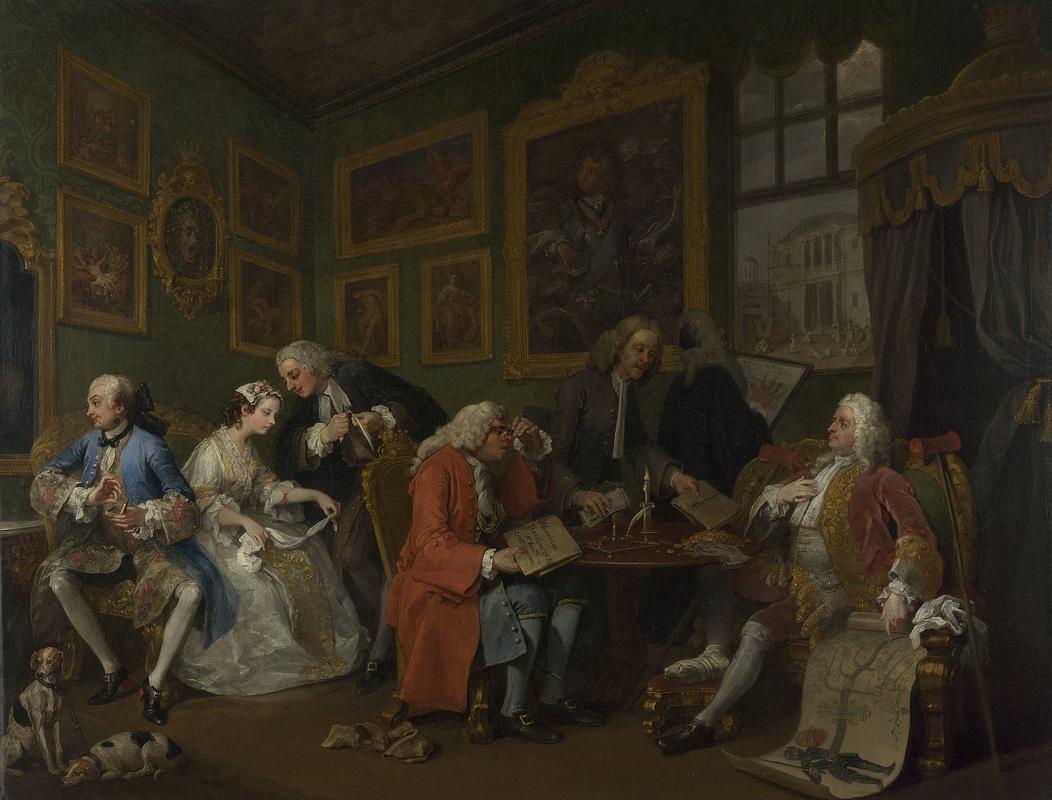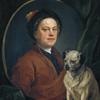More about Marriage A-la-Mode: 1, The Marriage Settlement

Contributor
Neither the bride nor the groom looks too thrilled here.
The Marriage Settlement is the first painting in William Hogarth’s satirical painting series titled "Marriage a la Mode" (roughly meaning “marriage of the day or marriage in the current fashion"). The aim of these paintings was to poke fun at the British aristocracy who, after centuries of not having jobs and just kind of lying around spending vast amounts of money, increasingly sought to tap into the growing wealth of the new merchant class. They often achieved this through largely arranged marriages, where the groom’s family would get the money needed to fix up the crumbling old manor house, and the bride would get the social capital associated with an aristocratic title. That’s exactly what’s going on in this painting.
The young couple is seated in the left of the painting, and they’re not even looking at each other. Hogarth’s skill as a printmaker who traded in popular and humorous subjects is evident in his use of caricature in this work. The emotions and actions of the subjects are exaggerated to comic effect.The young lord, appropriately named “Viscount Squanderfield” is too preoccupied checking himself out in the mirror as he takes a pinch of snuff to even notice his sobbing bride to be. Meanwhile, Lord Squanderfield and the bride’s merchant father negotiate the dowry while an architect examines plans for a new mansion.
This painting is also rich with detail and symbolism. Dogs play a prominent role in "Marriage a la Mode" as a whole, and the two chained dogs seen by the unhappy couple are a portent of the loveless marriage to come. Viewers of the time could easily read these symbols commonly deployed in the moralistic or genre paintings to read the social criticism embedded in this work. This hot take on the maybe not so cool practices of the upper classes is exactly what Hogarth’s main fans, the merchant middle class with their growing buying power, were into, taking any chance to reduce the profile of the aristocracy.
Sources
- Farrell, Kaitlyn. "A Dog's World: The Significance of Canine Companions in Hogarth's "Marriage A-la-Mode"." The British Art Journal 14, no. 2 (2013): 35-38.
- Otterstein, Pola. "William Hogarth – Marriage à-la-mode." DailyArtMagazine.com - Art History Stories. May 23, 2018. http://www.dailyartmagazine.com/william-hogarth-marriage-la-mode/.
- "Hogarth: Hogarth's Modern Moral Series, Marriage A-la Mode." Tate. https://www.tate.org.uk/whats-on/tate-britain/exhibition/hogarth/hogart….
- "William Hogarth, Marriage A-la-Mode (including Tête à Tête)." Khan Academy. https://www.khanacademy.org/humanities/ap-art-history/early-europe-and-….

Featured Books & Academic Sources
The following is an excerpt from "Hogarth's Works: with Life and Anecdotal Descriptions of his Pictures, Second Series" by John Ireland and John Nichols, pulbished in 1880:
In his preceding prints Mr. Hogarth generally pointed his satire at persons in a subordinate situation, and took his examples from the inferior ranks of society. From the situation of his characters, and the minute precision with which he displayed the scenes he professed to delineate, we sometimes see little violations of that decorum which is perhaps necessary in engravings professedly designed for furniture. For this neglect of delicacy some of his prints were censured; to remove all apprehensions of this series being liable to the same objections, they were thus announced in the London Daily Post of April 7, 1743:—
"Mr. Hogarth intends to publish, by subscription, six prints from copperplates, engraved by the best masters in Paris after his own paintings; the heads, for the better preservation of the characters and expressions, to be done by the author, representing a variety of modern occurrences in high life, and called 'Marriage à la Mode.'
"Particular care is taken that the whole work shall not be liable to exception, on account of any indecency or inelegancy; and that none of the characters represented shall be personal, etc."
The artist has adhered to his engagement: he has struck at an higher order, and displayed the follies and vices which frequently degrade our nobility. He has exhibited the prospect of a fashionable marriage, where the gentleman is attracted by riches, and the lady by ambition. That misery and destruction succeeded an union founded upon such principles is not to be wondered at; the progress of that misery, and the final destruction of the actors, is so delineated as to form a regular and well-divided tragedy. In the first act are represented five principal characters; and three of them, by a regular chain of incidents naturally flowing from each other, fall victims to their own vices. The young nobleman, for attempting to revenge the violation of his wife's virtue, which he never cherished, is killed by her paramour, who for this murder suffers an ignominious death; and the lady, distracted at the reflection of having been the cause of their lives terminating in so horrid a manner, makes her own quietus with a dose of laudanum. This is painting to the understanding, appealing to the heart, and making the pencil an advocate in the cause of morality. It is doing that poetical justice which our dramatists have sometimes neglected, and in which they have perhaps been justified by the common events of human life; for it must be acknowledged, that while virtue is frequently unfortunate, we often see vice successful. Notwithstanding this, those pictures are surely best calculated to encourage men in the practice of the social duties which display the evils consequent upon their violation. Whatever poetical justice may allow, morality demands that some examples should be held up to prove "that the omission of a duty frequently leads to the perpetration of a crime; and that crimes of so black a dye as are here represented, almost invariably terminate in wretchedness, infamy, and death."
The original pictures were, on the 6th of June 1750, purchased by Mr. Lane of Hillingdon, near Uxbridge, for one hundred and twenty guineas!—a price so inadequate to their merit, and to what it might have been fairly presumed they would have produced even at that time, that it becomes difficult to account for it in any other way than by supposing that the strange way in which Mr. Hogarth ordered the auction to be conducted puzzled the public, who, not exactly comprehending this new mode of bidding, declined attending or bidding at all.
The following particulars relative to the sale were communicated by Mr. Lane to Mr. John Nichols:—
"Some time after the pictures had been finished, perhaps six or seven years, they were advertised to be sold by a sort of auction, not carried on by personal bidding, but by a written ticket, on which every one was to put the price he would give, with his name subscribed to it. These papers were to be received by Mr. Hogarth for the space of one month, and the highest bidder at twelve o'clock, on the last day of the month, was to be the purchaser: none but those who had in writing made their biddings were to be admitted on the day that was to determine the sale. This nouvelle method of proceeding probably disobliged the public, and there seemed to be at that time a combination against poor Hogarth, who, perhaps, from the extraordinary and frequent approbation of his works, might have imbibed some degree of vanity, which the town in general, friends and foes, seemed resolved to mortify. If this was the case (and to me it is very apparent), they fully effected their design; for on the memorable 6th of June 1750, which was to decide the fate of this capital work, about eleven o'clock, Mr. Lane, the fortunate purchaser, arrived at the Golden Head, when, to his great surprise, expecting (what he had been a witness to in 1745, when Hogarth disposed of many of his pictures) to have found his painting room full of noble and great personages, he only found the painter and his ingenious friend Dr. Parsons, secretary to the Royal Society, talking together, and expecting a number of spectators at least, if not of buyers. Mr. Hogarth then produced the highest bidding, from a gentleman well known, of £110. Nobody coming in, about ten minutes before twelve, by the decisive clock in the room, Mr. Lane told Mr. Hogarth he would make the pounds guineas. The clock then struck twelve, and Hogarth wished Mr. Lane joy of his purchase, hoping it was an agreeable one. Mr. Lane answered, 'Perfectly so.' Now followed a scene of disturbance from Hogarth's friend the Doctor, and what more affected Mr. Lane, a great appearance of disappointment in the painter, and truly with great reason. The Doctor told him he had hurt himself greatly by fixing the determination of the sale at so early an hour, when the people in that part of the town were hardly up. Hogarth, in a tone and manner that could not escape observation, said, 'Perhaps it may be so!' Mr. Lane, after a short pause, declared himself to be of the same opinion; adding, that the artist was very poorly rewarded for his labour, and if he thought it would be of service to him, would give him till three o'clock to find a better purchaser. Hogarth warmly accepted the offer, and expressed his acknowledgments for this kindness in the strongest terms. The proposal likewise received great encomiums from[6] the Doctor, who proposed to make it public. This was peremptorily forbidden by Mr. Lane, whose concession in favour of our artist was remembered by him to the time of his death. About one o'clock, two hours sooner than the time appointed, Hogarth said he could no longer trespass on his generosity, but that if he was pleased with his purchase, he himself was abundantly so with the purchaser. He then desired Mr. Lane to promise that he would not dispose of the pictures without previously acquainting him of his intention, and that he would never permit any person, under pretence of cleaning, to meddle with them, as he always desired to take that office on himself. This promise was readily made by Mr. Lane, who has been tempted more than once by Mr. Hogarth to part with his bargain at a price to be named by himself. When Mr. Lane bought the pictures they were in Carlo Maratte frames, which cost the painter four guineas a-piece."
On the death of Mr. Lane the six pictures became the property of his nephew Colonel Cawthorne, and were in the summer of 1792 put up by auction at Mr. Christie's, and the proprietor bought them in at nine hundred guineas.
They were a short time afterwards purchased by Mr. Angerstein, at one thousand guineas, and are now in his very fine collection.
If considered in the aggregate,—in conception, character, drawing, pencilling, and colouring,—it will not be easy, perhaps not possible, to find six pictures painted by any artist, in any age or country, in which such variety of superlative merit is united.
Since the publication of the first edition of these volumes, the following description of "Marriage à la Mode" was found among the papers of the late Mr. Lane of Hillingdon; and his family believe it to be Hogarth's Explanation, either copied from his own handwriting, or given verbally to Mr. Lane at the time he purchased the pictures. It is subjoined, that the reader may form his own judgment:—
EXPLANATION OF THE PAINTINGS OF THE LATE MR. HOGARTH, CALLED MARRIAGE A LA MODE.
"Where Titles deign with Cits to have and hold,
And change rich blood for more substantial gold;
And honour'd trade from interest turns aside,
To hazard happiness for titled pride."—Garrick.
The First Picture.
"There is always a something wanting to make men happy: the great think themselves not sufficiently rich, and the rich believe themselves not enough distinguished. This is the case of the Alderman of London, and the motive which makes him covet for his daughter the alliance of a great lord; who, on his part, does not consent thereto but on condition of enriching his son;—and this is what the painter calls marriage à la mode.
"These sort of marriages are truly but too common in England; and it is, moreover, not unfrequent to see them unhappy as they are ill chosen. The two figures of the Alderman and the Earl are in every respect so well characterized that they explain themselves. The Alderman, with an air of business, counts his money like a man used to this employment; and the Earl, full of his titles and the greatness of his birth, which he lets you see goes as high as William the Conqueror, is in an attitude which shows him full of pride; you think you hear him say me, my arms, my titles, my family, my ancestors: everything about him carries marks of distinction; his very crutches, the humbling consequence of his infirmities, are decked with an earl's coronet; these infirmities are introduced here as the usual consequence of that irregularity of living but too frequent among the great. The two persons who are betrothed, on their parts are by no means attentive to one another: the one looks at himself in the glass, is taking snuff, and thinking of nothing; the other is playing negligently with a ring, and seems to hear with indifference the conversation of a kind of a lawyer who attends the execution of the marriage articles. Another lawyer is exclaiming with admiration on the beauty of a building seen at a distance, and upon which the Earl has spent his whole fortune, and has not sufficient to finish the same. A number of idle footmen, who are about the court of this building, finish the representation of the ruinous pageantry in which the Earl is engaged."
Sources
- Ireland, John and John Nichols. Hogarth's Works : with Life and Anecdotal Descriptions of His Pictures, Second Series. London: Chatto and Windus, 1880.
Featured Content
Here is what Wikipedia says about Marriage A-la-Mode: 1. The Marriage Settlement

The Marriage Settlement is the first in the series of six satirical paintings known as Marriage A-la-Mode painted by William Hogarth, named after the historical legal arrangement of a Marriage settlement.
Check out the full Wikipedia article about Marriage A-la-Mode: 1. The Marriage Settlement












